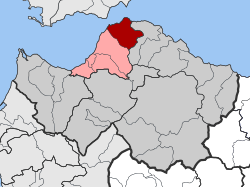Rio, Greece
Rio
Ρίο | |
|---|---|
| Coordinates: 38°18′N 21°47′E / 38.300°N 21.783°E | |
| Country | Greece |
| Administrative region | Western Greece |
| Regional unit | Achaea |
| Municipality | Patras |
| Area | |
| • Municipal unit | 98.983 km2 (38.218 sq mi) |
| Elevation | 40 m (130 ft) |
| Population (2021)[1] | |
| • Municipal unit | 14,219 |
| • Municipal unit density | 140/km2 (370/sq mi) |
| • Community | 5,430 |
| Time zone | UTC+2 (EET) |
| • Summer (DST) | UTC+3 (EEST) |
| Postal code | 265 xx |
| Area code(s) | 2610 |
| Vehicle registration | ΑΧ |
Rio (Greek: Ρίο, Río, formerly Ῥίον, Rhíon; Latin: Rhium) is a town in the suburbs of Patras and a former municipality in Achaea, Western Greece, Greece. Since the 2011 local government reform it is part of the municipality Patras, of which it is a municipal unit.[2] The municipal unit has an area of 98.983 km2.[3] The municipal unit had a population of 14,219 in 2021. The campus of the University of Patras and the Casino Rio is located in Rio.
Geography
[edit]Rion is the northernmost municipal unit of the Peloponnese peninsula. It stretches along the southeastern coast of the Gulf of Patras, about 7 km northeast of Patras city centre. The nearby Strait of Rio, crossed by the Rio–Antirrio bridge, separates the Gulf of Patras from the Gulf of Corinth to the east. The town is dominated by the Panachaiko mountain to the southeast.
Town layout
[edit]The town centre is also known as Agios Georgios Riou. This is where the Rio railway station, on the line from Patras to Corinth, is located. The quarter Kastellokampos lies to the southwest of the centre. The ferry terminals, with services to Antirrio, are in the north, on both sides of the Rio–Antirrio bridge. There is a large fortress with bastions next to the bridge. The campus of the University of Patras and the hospital lie in the southeast, across the Greek National Road 8A. There are sandy beaches along the coast, and a port north of town centre.
Subdivisions
[edit]The municipal unit Rio is subdivided into the following communities (constituent villages in brackets):
- Agios Vasileios
- Aktaio
- Ano Kastritsi
- Arachovitika (Arachovitika, Kato Arachovitika)
- Argyra
- Drepano
- Kato Kastritsi (Kato Kastritsi, Magoula)
- Pititsa
- Platani
- Psathopyrgos (Psathopyrgos, Kato Rodini)
- Rio
- Sella
History
[edit]The name Rio (and its older form Rhion) derives from the Greek ῥίον (rhion), generally meaning "jutting part",[4] perhaps from ῥίς (rhis), meaning "nose", but also "spur of land".[5] The earliest attested form of the word is the Mycenaean Greek 𐀪𐀍, ri-jo, written in Linear B syllabic script.[6]
The site of Rio has been a strategic point since antiquity. Early 19th century, there stood an old Turkish castle (the "Castle of the Morea") at the cape, with a small settlement outside its walls.[7]
Government
[edit]The mayors of the municipality were:
- Vasileios Zervas (1998–2006)
- Christos Liakopoulos (2006–2010)
Population
[edit]| Year | Municipal district | Municipality |
|---|---|---|
| 1981 | 2,012 | - |
| 1991 | 3,496 | 10,280 |
| 2001 | 5,231 | 13,291 |
| 2011 | 5,252 | 14,622 |
| 2021 | 5,430 | 14,219 |
Transport
[edit]Road
[edit]Highway 8 (Elefsina - Rio) passes through from Rio. It is also the terminus of National Road 8 (Old National Road Athens-Corinth-Patras). The town is served by urban transport buses with lines 6 and 9 and the Patras Suburban Railway, via the "Rio" stop & the " Kastellokampos - University/Hospital" bus line .
Rail
[edit]Rio Railway Station, opened as a station in 1887 and since 2010 served by the local trains to Agios Andreas and Patras by Suburban Railway of Patras. Rio Station is currently under reconstruction as part of the construction of the new Athens-Patras railway line, which (when finished) will connect the area with Athens. In order to ensure these needs, a new temporary station has been operating since 26 March 2019, at the height of Zaimi & Iroon Polytechneiou streets.[8]
Gallery
[edit]-
Neighborhood and Panachaiko mountain
-
Hospital and bridge
-
University library
-
Castle
-
Cemetery
See also
[edit]References
[edit]- ^ "Αποτελέσματα Απογραφής Πληθυσμού - Κατοικιών 2021, Μόνιμος Πληθυσμός κατά οικισμό" [Results of the 2021 Population - Housing Census, Permanent population by settlement] (in Greek). Hellenic Statistical Authority. 29 March 2024.
- ^ "ΦΕΚ B 1292/2010, Kallikratis reform municipalities" (in Greek). Government Gazette.
- ^ "Population & housing census 2001 (incl. area and average elevation)" (PDF) (in Greek). National Statistical Service of Greece.
- ^ ῥίον. Liddell, Henry George; Scott, Robert; A Greek–English Lexicon at the Perseus Project.
- ^ ῥίς in Liddell and Scott.
- ^ Found on, among others, the PY An 1 tablet. Cf. 𐀪𐀍𐀜, ri-jo-no, and variant forms, thought to be possibly derived from ri-jo plus the *-i-jo (perhaps -ίων) ethnic suffix. "The Linear B word ri-jo". "The Linear B word ri-jo-no". Palaeolexicon. Word study tool of ancient languages. "ri-jo". Raymoure, K.A. "ri-jo-no". Minoan Linear A & Mycenaean Linear B. Deaditerranean. "PY 1 An + fr. + fr. (1)". DĀMOS: Database of Mycenaean at Oslo. University of Oslo.
- ^ Leake, William Martin (1830). Travels in the Morea, Volume 2. London: John Murray. pp. 148–150.
- ^ "Πάτρα: Μεταφέρεται ο σταθμός του Προαστιακού στο Ρίο – Πώς διαμορφώνονται τα δρομολόγια". THE BEST (in Greek). 24 March 2019. Retrieved 31 December 2023.
External links
[edit]- Municipality of Rio (in Greek and English)







